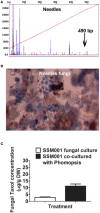Interactions between Co-Habitating fungi Elicit Synthesis of Taxol from an Endophytic Fungus in Host Taxus Plants
- PMID: 23346084
- PMCID: PMC3550802
- DOI: 10.3389/fmicb.2013.00003
Interactions between Co-Habitating fungi Elicit Synthesis of Taxol from an Endophytic Fungus in Host Taxus Plants
Abstract
Within a plant, there can exist an ecosystem of pathogens and endophytes, the latter described as bacterial and fungal inhabitants that thrive without causing disease to the host. Interactions between microbial inhabitants represent a novel area of study for natural products research. Here we analyzed the interactions between the fungal endophytes of Taxus (yew) trees. Fungal endophytes of Taxus have been proposed to produce the terpenoid secondary metabolite, Taxol, an anti-cancer drug. It is widely reported that plant extracts stimulate endophytic fungal Taxol production, but the underlying mechanism is not understood. Here, Taxus bark extracts stimulated fungal Taxol production 30-fold compared to a 10-fold induction with wood extracts. However, candidate plant-derived defense compounds (i.e., salicylic acid, benzoic acid) were found to act only as modest elicitors of fungal Taxol production from the endophytic fungus Paraconiothyrium SSM001, consistent with previous studies. We hypothesized the Taxus plant extracts may contain elicitors derived from other microbes inhabiting these tissues. We investigated the effects of co-culturing SSM001 with other fungi observed to inhabit Taxus bark, but not wood. Surprisingly, co-culture of SSM001 with a bark fungus (Alternaria) caused a ∼threefold increase in Taxol production. When SSM001 was pyramided with both the Alternaria endophyte along with another fungus (Phomopsis) observed to inhabit Taxus, there was an ∼eightfold increase in fungal Taxol production from SSM001. These results suggest that resident fungi within a host plant interact with one another to stimulate Taxol biosynthesis, either directly or through their metabolites. More generally, our results suggest that endophyte secondary metabolism should be studied in the context of its native ecosystem.
Keywords: Paraconiothyrium; Taxol; Taxus; elicitor; endophyte; fungus.
Figures




Similar articles
-
A fungal endophyte induces transcription of genes encoding a redundant fungicide pathway in its host plant.BMC Plant Biol. 2013 Jun 26;13:93. doi: 10.1186/1471-2229-13-93. BMC Plant Biol. 2013. PMID: 23802696 Free PMC article.
-
Exogenous and endogenous increase in fungal GGPP increased fungal Taxol production.Appl Microbiol Biotechnol. 2017 Oct;101(20):7523-7533. doi: 10.1007/s00253-017-8509-9. Epub 2017 Sep 16. Appl Microbiol Biotechnol. 2017. PMID: 28918530
-
An Endophyte Constructs Fungicide-Containing Extracellular Barriers for Its Host Plant.Curr Biol. 2015 Oct 5;25(19):2570-6. doi: 10.1016/j.cub.2015.08.027. Epub 2015 Sep 24. Curr Biol. 2015. PMID: 26412131
-
Exploiting the Biosynthetic Potency of Taxol from Fungal Endophytes of Conifers Plants; Genome Mining and Metabolic Manipulation.Molecules. 2020 Jun 30;25(13):3000. doi: 10.3390/molecules25133000. Molecules. 2020. PMID: 32630044 Free PMC article. Review.
-
[Advances and prospects of taxol biosynthesis by endophytic fungi].Sheng Wu Gong Cheng Xue Bao. 2016 Aug 25;32(8):1038-1051. doi: 10.13345/j.cjb.150519. Sheng Wu Gong Cheng Xue Bao. 2016. PMID: 29022305 Review. Chinese.
Cited by
-
Endophytic fungi: a potential source of industrial enzyme producers.3 Biotech. 2022 Apr;12(4):86. doi: 10.1007/s13205-022-03145-y. Epub 2022 Mar 3. 3 Biotech. 2022. PMID: 35273898 Free PMC article. Review.
-
Endophytic fungi mediates production of bioactive secondary metabolites via modulation of genes involved in key metabolic pathways and their contribution in different biotechnological sector.3 Biotech. 2023 Jun;13(6):191. doi: 10.1007/s13205-023-03605-z. Epub 2023 May 14. 3 Biotech. 2023. PMID: 37197561 Free PMC article. Review.
-
Evaluation of spore inoculum and confirmation of pathway genetic blueprint of T13αH and DBAT from a Taxol-producing endophytic fungus.Sci Rep. 2020 Dec 3;10(1):21139. doi: 10.1038/s41598-020-77605-x. Sci Rep. 2020. PMID: 33273486 Free PMC article.
-
Biodiversity of genes encoding anti-microbial traits within plant associated microbes.Front Plant Sci. 2015 Apr 10;6:231. doi: 10.3389/fpls.2015.00231. eCollection 2015. Front Plant Sci. 2015. PMID: 25914708 Free PMC article. Review.
-
Origin and Evolution of Enzymes with MIO Prosthetic Group: Microbial Coevolution After the Mass Extinction Event.Front Genet. 2022 Mar 29;13:851738. doi: 10.3389/fgene.2022.851738. eCollection 2022. Front Genet. 2022. PMID: 35422843 Free PMC article.
References
-
- Amborabé B.-E., Fleurat-Lessard P., Chollet J.-F., Roblin G. (2002). Antifungal effects of salicylic acid and other benzoic acid derivatives towards Eutypa lata: structure-activity relationship. Plant Physiol. Biochem. 40, 1051–1060
LinkOut - more resources
Full Text Sources
Other Literature Sources

